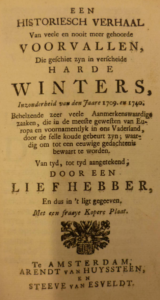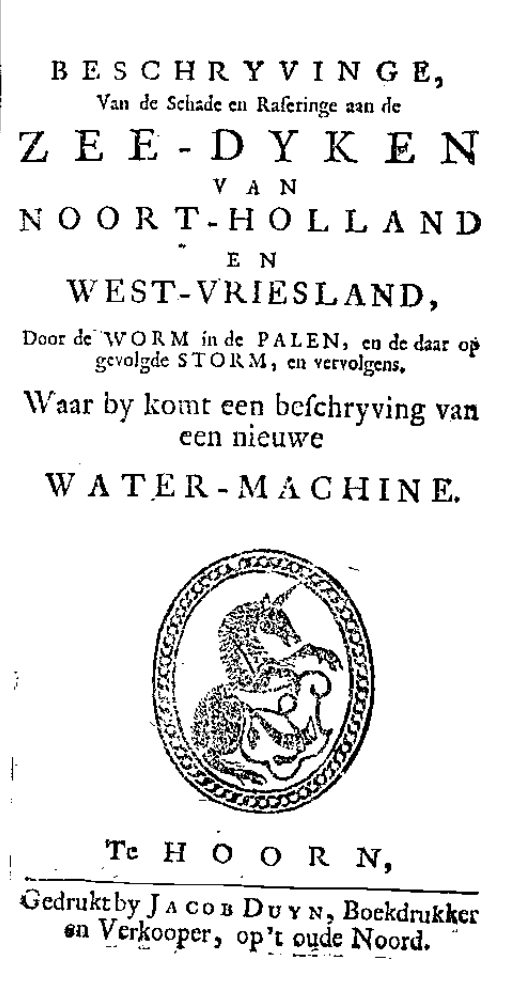In post 3/3 of my series on unusual connections, I want to broaden the scope my argument beyond simply river floods and shipworms. Disasters in the Dutch 18th century were all connected!
In a sense, this is the principal argument of my manuscript. The eighteenth century was (relatively) disastrous for the Dutch Republic.(1) After enjoying a century of prosperity, the Golden Age of Dutch economic success, artistic efflorescence, and political influence had begun to wane by the eighteenth century. Disasters reflected new anxieties about this change of circumstances just as they contributed to increasing financial pressures.

An anonymous pamphlet detailing the terrible consequences of the “hard winter” between 1739-1740. Anon. Een historiesch verhaal van veele en nooit meer gehoorde voorvallen, die geschiet zyn in verscheide harde winters, inzonderheid van den jaare 1709. en 1740
Natural disasters were certainly not new to the eighteenth century and there is no indication that they increased in number between 1650-1750, but the reaction to them shifted.(2) Natural disasters unearthed buried social tensions, prompted providential reevaluations, and produced intense reconsideration of the Dutch relationship with their environment. (3)
In this perfect storm of cultural, economic, and environmental uncertainty, contemporaries linked disasters together. Naturally, causal connections were stronger in some situations than others. Adverse weather, particularly harsh winters like 1740-1741, created numerous rippling effects and directly or indirectly contributed to several other demographic and environmental disasters. In addition to the direct consequences of frigid conditions (reports of cattle and sometimes even people dying from exposure abound), historians have indirectly connected adverse weather to a widespread mortality wave in the Netherlands and across Europe via failed harvests. (4) Furthermore, frigid conditions prompted the formation of ice dams on Dutch waterways. One can even connect these stressful environmental conditions to cattle plagues. Lack of fodder and prolonged exposure to adverse conditions likely weakened the immune systems of cattle making them more susceptible to disease. Rivers, on the other hand, had very little direct causal connection to the shipworm epidemic outside of the circumstances mentioned in these post.
Independently of direct environmental causation, however, contemporaries discursively linked the disasters of the 18th century. Rural communities merged disasters together in their petitions for remission from provincial taxation. The burden of rebuilding dikes in the wake of river floods (or shipworms) combined with the need to replenish cattle stocks after cattle plague epidemics) while also shouldering their usual tax burden, residents argued, was untenable.

Consideration for the remission of taxation related to the shipworm infestation in West Friesland. Source: Westfries Archief 1662.424
The most common discursive linkages were providential. Disasters pointed to God’s wrath and confirmed the sinful state of the Dutch Republic. Clergy and laypeople discursively connected disasters in order to build a case for providential causation. Each successive disaster was further proof of this “sin economy.” Causal stories grounded in divine providence were far from uniform and they could be tailored to suit any numbers of agendas. Providential readings of disasters could challenge or support political ideologies, promote or discourage technological adaptation, or inspire emotional connection to disasters victims. (5) Regardless, repeated disasters like that of the shipworms epidemic and the mid-century river floodings strengthened these interpretations.
Finally, water authorities likewise created discursive connections between disastrous events, in particular river flooding and coastal flooding. This was very apparent in the 1730s during the shipworm epidemic and in the wake of disastrous river floods along the Rhine in 1726 and 1740-41. By the 1740s, paranoia about the breaking of the northern Lekdijk had become fever pitch. (6) The 1740-41 floods were not incredibly deadly but they were extensive. By the 1750s, it seemed almost a miracle that the northern Lekdijk, which protected much of the Green Heart of Holland, had not yet broken. Water authorities like Velsen were deeply cognizant of the vulnerability of the economic center of the country to flooding if the northern dike along the Lek fell. If that were to happen, the entire area between the river lands and the river IJ near Amsterdam could be inundated.

Source: Rijksmuseum. This map is a copy of Melchior Bolstra, Figuratieve kaart vande Situatie van Gelderland, Holland, Uytrecht en OverYzel, ten regarde van Zee, en Rivieren (1744)
At the same time, flood vulnerability was becoming an object of increasing concern in northern Holland. By 1733, West Frisian water boards had shifted the discourse surrounding shipworms from a novel biological disaster (for which there was still no adequate response) to the more manageable threat of coastal flooding.

The title page of a pamphlet that collected dike reports and advice from the West Frisian water authorities. The West Frisian sea dikes must be “a barrier against the sea for the entirety of Holland, and must also be used as a fortress that protects the entirety of Holland” – Seger Lakenman 12 Jan, 1732
If the West Frisian sea dikes failed, the water boards argued, the “fortress” of northern Holland (in particular the “Westfries Omringdijk) from West Friesland south to the IJ could be turned into a “bare sea.” The vulnerability discourses of North and South Holland were complimentary and even shared the same language. Should these disasters occur simultaneously, Holland would face an existential threat. Both Velsen and the designers of the new shipworm-proof sea dikes of West Friesland harnessed this discourse to their advantage, though Velsen would enjoy far less success in realizing his proposals.
Although the shipworm epidemic of the 1730s and the river flooding between 1726 and the 1750s seem to have little in common, closer inspection reveals numerous connections. In this series of posts, I’ve highlighted three connections, but this only scratches the surface of possible relationships. Governing governing bodies sometimes used disasters management efforts as political tools to further their own, more local interests. For instance, several cities along the Meuse river blocked a subsidy for the repair of West-Frisian sea dikes during the shipworms epidemic in 1735 in order to push through their goals. One of the consequences of the increasing consolidation of water management under the provinces was that the disaster management needs of one region could become beholden to those of another.
It should perhaps come as no surprise that disasters beget other disasters. Scholars often focus on direct causal relationships stemming from persistent social or economic disadvantage, environmental (oftentimes climatic) influence, or poor management of infrastructure to explain these relationships. These connections were likewise influential in the early modern Dutch Republic. The increasing consolidation and integration of large scale water management in Holland as well as the province’s growing reliance upon “expert” advice in the eighteenth century ensured financial and technological relationships between seemingly disconnected disasters. At the same time, contemporaries crafted discursive relationships between disasters separated by years (even decades) in their ambition to create disaster mitigation strategies and to lessen the financial burden of the events. Providential interpretations used a similar strategy in order to promote moral interpretations and responses to these periods of disaster.
“Unlikely connections” were not limited to the relationships between shipworms and river floods either. One could just as easily tally off similar connections between shipworms and coastal flooding or cattle plagues. The nature of disaster interpretation and management in the Dutch eighteenth century would seem to have facilitated many of these relationships. A compelling argument might also be made, however, that this was not a condition of pre-modern disasters. Disasters are still frequently linked together, causally, institutionally, and discursively. Scholars should certainly not abandon seeking environmental or social relationships between disasters, especially in the early modern period, but many other types of connections (cultural, moral, technological, political) abound as well.
(1) Johan de Vries, De economische achteruitgang der republiek in de achttiende eeuw, 1968
(2) Indeed, there is little reason to believe that river floods or storm surges increased in number over the course of the 18th century, though there is some indication that they increased in severity. The shipworm epidemic and cattle plagues were exceptions in that they certainly increased in severity and number.
(4) John Dexter Post, The Last Great Subsistence Crisis in the Western World (1977)
(5) Marijke Meijer Dress, “’Providential discourse reconsidered: the case of the Delft Thunderclap’,” Dutch Crossing: Journal of Low Countries Studies 2 (2016):108-121.
(6) Paul van den Brink, “Rijnland en de rivieren: Inrichting en vormgeving van de Hollandse rivierzorg in de achttiende eeuw,” Tijdschrift voor Waterstaatsgeschienis 12 (2003).
(7) Adam Sundberg, “An Uncommon Threat: Shipworms as a Novel Disaster,” Dutch Crossing: Journal of Low Countries Studies 2 (2016).
